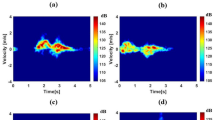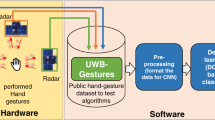Abstract
The feasibility of recognizing different human–human interactions based on the time-range dimension is investigated. Measured data of six kinds of human–human interactions including hugging, kicking, pointing, punching, pushing, and shaking hands were collected by ultra-wideband radar (UWB). By observing the variation of the time-range dimension matrix, the time-varying UWB signatures are characterized in a time window. Four features are extracted from a time-range dimension matrix by analyzing the characteristics of time-varying UWB signatures. K-nearest neighbor is used to recognize six kinds of human–human interactions based on four measurement features, and the recognition accuracy is found to be up to 99%. In addition, the results obtained by the proposed recognition algorithm are compared with those obtained by other feature extraction algorithms, which further demonstrates the superiority and generalization ability of the algorithm. In addition, the recognition accuracy of the proposed algorithm is higher than some deep learning algorithms, including AlexNet, VGGNet, ResNet, and DenseNet in the case of small samples.







Similar content being viewed by others
References
Kellokumpu, V., Pietikäinen, M., Heikkilä, J.: Human activity recognition using sequences of postures. In: MVA, pp. 570–573 (2005)
Lara, O.D., Labrador, M.A.: A survey on human activity recognition using wearable sensors. IEEE Commun. Surv. Tutor. 15(3), 1192–1209 (2012)
Nguyen, N., Yoshitaka, A.: Classification and temporal localization for human–human interactions. In: 2016 IEEE Second International Conference on Multimedia Big Data (BigMM), pp. 74–81. IEEE (2016)
Liu, B., Cai, H., Ji, X., et al.: Human–human interaction recognition based on spatial and motion trend feature. In: 2017 IEEE International Conference on Image Processing (ICIP), pp. 4547–4551. IEEE (2017)
Stergiou, A., Poppe, R.: Understanding Human–Human Interactions: A Survey. arXiv preprint arXiv:1808.00022 (2018)
Yang, Y., Hou, C., Lang, Y., Guan, D., Huang, D., Xu, J.: Open-set human activity recognition based on micro-Doppler signatures. Pattern Recogn. 85, 60–69 (2019)
Erol, B., Gurbuz, S.Z., Amin, M.G.: GAN-based synthetic radar micro-Doppler augmentations for improved human activity recognition. In: 2019 IEEE Radar Conference (RadarConf), pp. 1–5 (2019)
Otero, M.: Application of a continuous wave radar for human gait recognition. In: Signal Processing, Sensor Fusion, and Target Recognition XIV. International Society for Optics and Photonics, vol. 5809, pp. 538–549 (2005)
Anderson, M.G., Rogers, R.L.: Micro-Doppler analysis of multiple frequency continuous wave radar signatures. In: Radar Sensor Technology XI. International Society for Optics and Photonics, vol. 6547, p. 65470A (2007)
Alnujaim, I., Oh, D., & Kim, Y.: Generative adversarial networks to augment micro-Doppler signatures for the classification of human activity. In: IGARSS 2019–2019 IEEE International Geoscience and Remote Sensing Symposium, pp. 9459–9461. IEEE (2019)
Du, H., Jin, T., Song, Y., Dai, Y.: Unsupervised adversarial domain adaptation for micro-Doppler based human activity classification. IEEE Geosci. Remote Sens. Lett. 17, 62–66 (2019)
Yang, Y., Lu, C.: Human identifications using micro-Doppler signatures. In: Proceedings of the ARP, pp. 69–73 (2008)
Hunt, A.R.: A wideband imaging radar for through-the-wall surveillance. In: Sensors, and Command, Control, Communications, and Intelligence (C3I) Technologies for Homeland Security and Homeland Defense III, International Society for Optics and Photonics, vol. 5403, pp. 590–596 (2004)
Hunt A.R.: Image formation through walls using a distributed radar sensor network. In: Sensors, and Command, Control, Communications, and Intelligence (C3I) Technologies for Homeland Security and Homeland Defense IV. International Society for Optics and Photonics, vol. 5778, pp. 169–174 (2005)
Yang, Y., Fathy, A.E.: See-through-wall imaging using ultra wideband short-pulse radar system. In: 2005 IEEE Antennas and Propagation Society International Symposium, vol. 3, pp. 334–337. IEEE (2005)
Bryan, J., Kim, Y.: Classification of human activities on UWB radar using a support vector machine. In: 2010 IEEE Antennas and Propagation Society International Symposium, pp. 1–4. IEEE (2010)
Bryan, J.D., Kwon, J., Lee, N., et al.: Application of ultra-wide band radar for classification of human activities. IET Radar Sonar Navig. 6(3), 172–179 (2012)
Qi, F., Liang, F., Lv, H., et al.: Detection and classification of finer-grained human activities based on stepped-frequency continuous-wave through-wall radar. Sensors 16(6), 885 (2016)
Jordan, T.S.: Using convolutional neural networks for human activity classification on micro-Doppler radar spectrograms. In: Sensors, and Command, Control, Communications, and Intelligence (C3I) Technologies for Homeland Security, Defense, and Law Enforcement Applications XV. International Society for Optics and Photonics, vol. 9825, p. 982509 (2016)
Yu, C.C., Cheng, H.Y., Hwang, J.N., et al.: Human body modeling with partial self occlusion from monocular camera. In: IEEE Workshop on Machine Learning for Signal Processing, pp. 193–198. IEEE (2008)
Mou, X., Wang, H., Lim, K.L.: Scale-adaptive multiple-obstacle tracking with occlusion handling in maritime scenes. In: 2016 12th IEEE International Conference on Control and Automation (ICCA), pp. 588–592. IEEE (2016)
Ryoo, M.S., Aggarwal, J.K.: UT-interaction dataset, ICPR contest on semantic description of human activities (SDHA). In: IEEE International Conference on Pattern Recognition Workshops, vol. 2, p. 4 (2010)
Forouzanfarm, M., Mabrouk, M., Rajan, S., et al.: Event recognition for contactless activity monitoring using phase-modulated continuous wave radar. IEEE Trans. Biomed. Eng. 64(2), 479–491 (2017)
Liubing, J., Cong, L., Li, C.: Human motion recognition by-ultra-wide band radar. J. Electron. Meas. Instrum. 32(1), 129–134 (2018). (in Chinese)
Liubing, J., Cong, L., Li, C.: Human motion recognition using ultra-wide band radar based on two-dimensional wavelet packet decomposition. J. Electron. Meas. Instrum. 32(8), 69–75 (2018). (in Chinese)
Jiang, J., Jiang, T., Zhai, S.: A novel recognition system for human activity based on wavelet packet and support vector machine optimized by improved adaptive genetic algorithm. Phys. Commun. 13, 211–220 (2014)
Krizhevsky, A., Sutskever, I., Hinton, G.E.: Imagenet classification with deep convolutional neural networks. In: Advances in Neural Information Processing Systems, pp. 1097–1105 (2012)
Simonyan, K., Zisserman, A.: Very Deep Convolutional Networks for Large-Scale Image Recognition. arXiv preprint arXiv:1409.1556 (2014)
He, K., Zhang, X., Ren, S., et al.: Deep residual learning for image recognition. In: Proceedings of the IEEE Conference on Computer Vision and Pattern Recognition, pp. 770–778 (2016)
Huang, G., Liu, Z., Van Der Maaten, L., et al.: Densely connected convolutional networks. In: Proceedings of the IEEE Conference on Computer Vision and Pattern Recognition, pp. 4700–4708 (2017)
Author information
Authors and Affiliations
Corresponding author
Additional information
Publisher's Note
Springer Nature remains neutral with regard to jurisdictional claims in published maps and institutional affiliations.
Rights and permissions
About this article
Cite this article
Liu, H., Yang, R., Yang, Y. et al. Human–human interaction recognition based on ultra-wideband radar. SIViP 14, 1181–1188 (2020). https://doi.org/10.1007/s11760-020-01658-8
Received:
Revised:
Accepted:
Published:
Issue Date:
DOI: https://doi.org/10.1007/s11760-020-01658-8




